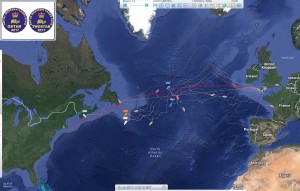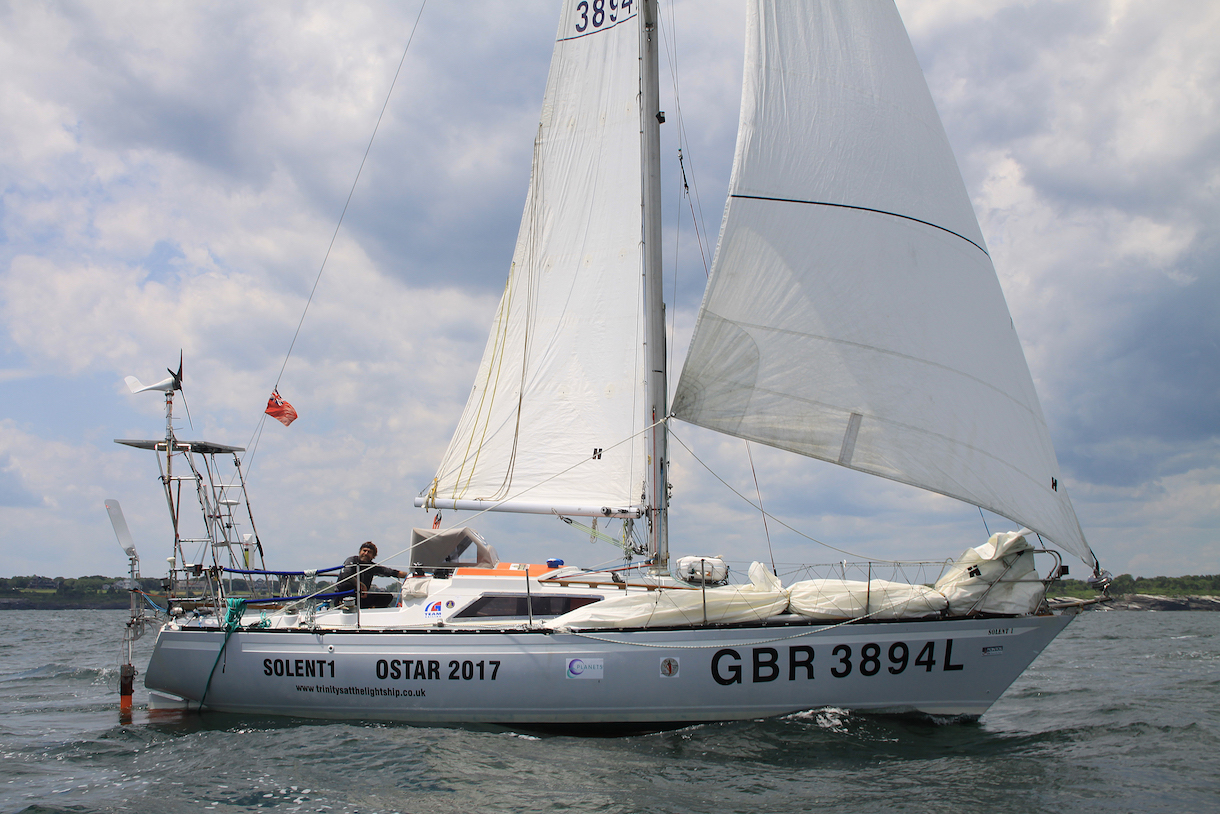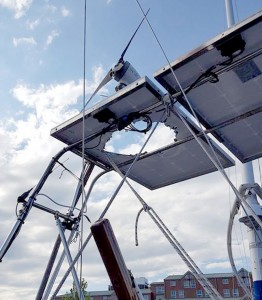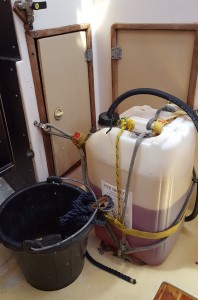
Neil Payter, his boat, Solent 1, is a 33ft Yamaha, with a small added bowsprit for the reaching sail
John Clarke, the Principal of Team Sailing, interviews Neil Payter RYA Yachtmaster instructor, following Neil’s completion of the 2017 OSTAR transatlantic race. A video of Neil’s homecoming is below
“I feel that the reason Solent 1 came through
it OK was as a result of
being an older and stronger boat”
In 1959 the Royal Western Yacht Club responded to a request from Lt Col H G (Blondie) Hasler to organise a single- handed race against the prevailing winds and current across the Atlantic. The 1960 Observer Singlehanded Transatlantic Race (OSTAR) was the result. Five yachts sailed from Plymouth to New York and, remarkably, all five finished with Francis Chichester coming first in Gipsy Moth III.
The second OSTAR (now from Plymouth to Newport, RI) in 1964 had a significant impact. The race was won by Eric Tabarly in Pen Duick II who, on his return to France, was fêted by the public and honoured by President de Gaulle. Out of this grew the French obsession with long-distance single-handed racing.
JC. Neil, I happen to know that your parents were not sailors, and that your trade was as a plumber. So how did you get involved in sailing?
I learned to sail with my grandfather on his Mirror Offshore, a 19ft sail boat, in Langstone and Chichester Harbour. For me it was mostly so that I could go fishing.
At the age of fourteen I got a job (when I should have been at school) working as a deckhand on a charter fishing boat out of Langstone Harbour. But I packed that in when the owner bought the little ferry which runs from Portsmouth to Hayling Island, and I didn’t fancy working on that for the rest of my life.
In the eighties, I went to Rhodes in Greece working as a deckhand for a season with a yacht charter company, and then the next year I found myself skippering for them.

Half-way across on 13 June 2017, Solent 1 leading in the Jester class with her pale blue crown. Note several boats heading for home
JC. And your first single-handed experience?
I first sailed single-handed in 1988 when I was in my early twenties. I had bought a little 22 ft mini-tonner Caramel Last 22, which I fitted out myself and I took down alone to the Med and around the Med. Eventually I sold her in Fuerteventura in the Canaries. Since then various cross-channel and south coast sails. In 2015, I entered and completed the solo AZAB (Azores and back) race on Solent 1. And then in 2016 I went in the single-handed Fastnet Race, which I must say I found extremely tough – tougher than the AZAB.
JC. What on earth made you want to do the OSTAR?
I read about the race as a teenager, and was inspired by those early pioneers of solo racing. I think with hindsight that all my sailing since then has been subconsciously with this end-point in view. I provisionally entered immediately on my return from the AZAB.
JC. Tell us about your boat, Solent 1.
She is a Yahama 33 footer (10m) built in 1981, designed by Peter Norm in the ¾ tonner class. She spent 31 years in the Solent and Channel as a training boat, and I’m sure that many CS readers will have done their Yachtmaster Exam on her. Then my partner Maria and I bought her about 7 years ago. She (the boat, not Maria) is a single-spreader masthead sloop, with slab reefing and hanked-on jibs. Though I had a small bowsprit added for the reaching sail, with a self-furler, especially for this race.
JC. There were twenty-two entries in the race, and only seven finished. To what do you attribute your surviving it and to what do you attribute such a high attrition rate?
I can’t really comment on why the other boats did or didn’t survive or retired. I feel that the reason Solent 1 came through it OK was as a result of being an older and stronger boat. Those GRP boats built in the eighties were all extremely well-built, with matt and resin the thickness of your hand, unlike the modern boats which, although built in temperature and humidity controlled environments, are extremely thin. Also, the modern trend for simply having a matrix surrounding the keel, as the recent disaster with Cheeki Rafiki illustrates all too sadly, shows the hazards all too well. They may be good Channel and Med boats, but would they have survived the storm we encountered? I don’t know. All I can say is that I was extremely lucky. There were many occasions when the boat was on her ears, and the loose cooker, for example, could so easily have smashed through a window, as happened to poor Mervyn Wheatley.
JC. Let’s move on, and tell us all your tactics during the storm.
It wasn’t so much tactics as thinking on my feet. Just using my initiative. As the storm began to impact I was thinking about taking in the storm jib and deploying the drogue, which as you know we had practiced using in March this year in the Solent. But unfortunately, the working jib was swept overboard, because I negligently hadn’t secured it properly to the deck and it was acting as a sea anchor, with the tack still attached. This left me dangerously beam on to the seas. I therefore had no option but to deploy the parachute anchor from the bow to bring her nose to the wind, so that I could retrieve the jib. This resulted in an extremely violent motion with the boat going from tack to tack, which damaged the self-steering gear. The 100 metres of rode chafed through within 10 minutes – I would have cut it through if it hadn’t chafed.
So, I couldn’t deploy the drogue, because the rode had now gone. My next trick was to deploy the trysail, and I found that I could sit at about 60º to the wind, with the tiller lashed hard to leeward. Unfortunately, the breaking seas would pick the boat up and throw her down on her beam. Then fortunately the trysail would impact and help her to weathercock the bow into the wave.
JC. You make it sound routine, but I’m sure that the conditions were horrific.
Yes, it was quite hairy, but I’ve always learned from our sailing guru Trevor Clifton, who writes for the magazine, and who took his little Twister down from Portsmouth round Cape Horn and back again single-handed (CS006). He is the calmest sailor I’ve ever sailed with, and “Don’t panic Mr Mainwaring” is his motto.
The wind was blowing at a good 60 knots and the waves were 15 metres high with the associated 15 metre troughs. They were breaking heavily, and the foam and the spindrift seemed to be as high as 2 metres. Because the waves were so high, I couldn’t get the parachute anchor, with 100 metres of rope, to reach the next crest when I was at the crest, which is what I think caused the violent motion and the rode to chafe through. Also, we hadn’t practised its use, which was an oversight.
After I had repaired the wind vane steering, with the trysail up, I could, as I said, sail on a close reach at about 2.5 knots, and that was relatively okay.
I deliberately chose to go on starboard tack as I felt that, being north of the depression, I would be sailing away from the centre of the low and in the direction of Newport, Rhode Island.
Anyway, after about 36 hours the conditions eased and we could resume sailing again.
JC. Quite dramatic, but obviously it wasn’t always like that. Were you never lonely?
No, I was never lonely, I think that with my satellite phone I was in touch with the shore and could chat to Maria if I wanted to. And I also had my kindle thank goodness, because I was taking in so much water that the books I had taken were all saturated.
And then I watched a DVD each day (remember that Solent 1 had all the home comforts of a cruising yacht). In fact, one of the DVDs was Master and Commander, which I gave to the French guy who came first in class over here in Newport – he was highly amused by this. Sleeping wasn’t a problem, with the AIS and the radar target enhancer I could be pretty relaxed especially as we weren’t near any major shipping lanes.
JC. So, overall, what were the high points?
Well, leading my class at one stage was clearly a surprise and a high point. I wanted to finish in 30 days, so considering the conditions, to finish in 35 days was good. Another pleasant surprise was the hospitality and welcome from the Royal Western and Newport Yacht Clubs
JC. Maria was telling me something about your hunt for a dead whale. Can you expand?
When I was off Nantucket Shoals on the approaches to Newport I had just come out of a fog bank as it was getting dark, I saw a very large white object in the water, which looked like an upturned boat, so I stopped Solent 1 and reported to the Coastguard. At the same time the US Coastguard had put out a Pan Pan about a missing boat. They asked me to hold station while they sent out a plane. When I went back and did a search pattern, located it and got closer, I saw that in fact it was a dead whale.
JC. Any desire to do it again, or are you, like me, now too old?
Yes but don’t tell Maria. And I’d like to do it on a Class 40, if I can get the sponsorship to rent one. Advice given to me last year by a previous competitor was “don’t do it”, cos it’s too scary. But Maria is even scarier, so it’s good to get away.
JC. Well done, mate, and have a good trip back, with hopefully much calmer conditions, and plenty of opportunities to set the spinnaker. See you in Kinsale (I’m hoping, dear reader, to join Neil in Kinsale to bring the boat back the last few hundred miles to Portsmouth Harbour) ★
Damage to Neil’s boat during the race.
• The wind generator worked loose,
caused by a weld breaking in the storm
• There are two solar panels mounted on a
frame on the stern. The loose wind
generator chewed up the starboard solar panel
• In the process, the wind generator
mountings broke, which I couldn’t
fix for another two days because of the
horrendous conditions. Then I was able
to re-mount it, using a boat hook and a
jubilee clip as a splint
• Tore the reaching jib
• Tore the number 2 blade jib
• Spinnaker pole was swept overboard
• Lost the sea anchor and rode. Broken
strands on both the upper and lower
port shrouds
• Spreader roots loosened
• Stainless steel bowsprit for the reaching sail was bent 2 inches

The broken toilet outlet, Neil said in his bunk he would put his foot on the cabin sole to feel the water inside the boat and then rise to bail out
• Heads sea cock blew off, and a wooden
bung was inserted. Then the valve was
replaced at sea
• Mainsail leech tore
• Two battens broke
• Water tank contaminated by sea water
entering through the vent pipe
• Fuel tank contaminated by sea water
entering through the vent pipe. Tank
bypassed and rigged to a Jerry can
• The glass bowl which houses the primary
fuel filter cracked, causing a major diesel
leak to the boat’s interior
• Webasto heater was damaged by water
• Cooker broke loose
• Major water ingress to interior of boat
OSTAR 2017 The storm that caused Tamarind to be scuppered
The 2017 race suffered unusually severe weather, and six of the boats that left Plymouth retired in the first week due to bad weather, well before the storm struck. Then in mid-Atlantic a storm force 11 wind hit the fleet. The winds were hitting 60 knots with 15 metre waves. One of the boats Tamarind, skippered by Mervyn Wheatley, was knocked over during the storm in the early hours of the Friday morning, and he scuppered the boat so it would not be a danger to other shipping.
Said his wife Penny: “He was down below when the mast went under water. It meant everything was thrown across the cabin and he thinks some plywood went through the porthole and in came the water.”
John Lewis, race director at Royal Western Yacht Club (RWYC) which hosted the race, said that Mr Wheatley’s decision to sink his ship would have been “traumatic” since “a boat to a skipper is a friend and a support”.
Mr Lewis said that the depression the fleet encountered was “unusually extreme”, adding that this storm was more serious than the Fastnet disaster of 1979, a storm which claimed the lives of 15 yachtsmen and three rescuers.
Of the 21 boats that started in the race, only nine were still in the running after the storm hit. Subsequently another two retired and there were only seven finishers, from the initial starters “We have run this race every four years since 1960 and this is the worst we’ve ever had,” Lewis said.
Wheatley is one of the OSTAR’s best known skippers, a hugely experienced sailor, a former Royal Marine who has sailed over 260,000 miles, was a skipper on the first ever Clipper round the world race and has done five Round Britain & Ireland Races, seven Azores and Back (AZAB) races and many previous OSTARs.
The UK Coastguard and counterparts in Halifax, Canada, launched a long-range rescue mission involving an RAF C-130 Hercules after detecting a distress beacon at around 4am.
Meanwhile coordinators radioed the luxury liner QM2 for assistance, which diverted her course and headed to the scene, arriving at around 1pm on Saturday. They took him on board and he had a luxury trip to Halifax.
Mr Wheatley, a father-of-two of Newton Ferrers, Devon, served 33 years as an officer in the Royal Marines, according to the RWYC.
Daniel Bailey, operations officer for the UK Coastguard, said: “We are extremely grateful for the support and professionalism that the RMS Queen Mary 2 provided during this rescue.”
The wind was blowing at a good 60 knots
and the waves were 15 metres high
with the associated 15 metre troughs
This story appeared in the August-September 2017 issue of Classic Sailor: No17
Video of Neil’s return to a Haslar reception after the OSTAR




